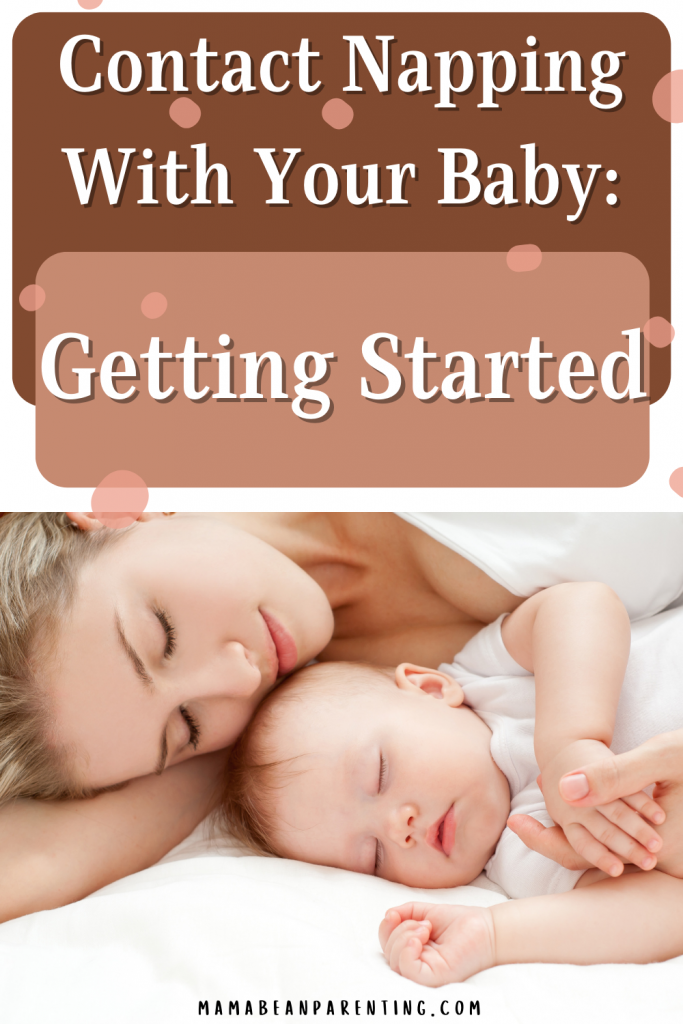No matter how hard you try, no matter what you try, sometimes it seems impossible to get your baby to fall asleep. For many parents, this causes a great deal of stress and anxiety. If your baby finds getting the rest they need challenging, try contact napping.
Babies adore physical closeness with their mothers. To your baby, it’s the safest place imaginable – not to mention the warmest and the coziest. Contact naps have been proven to have many benefits. These benefits include not only your baby but you as well.
Even if your baby faces no difficulty falling asleep, introducing contact sleeping into their sleep schedule is an excellent way for you and your baby to experience closeness and bonding.
Before we get into the why and the how let’s examine the many benefits of contact napping and why parents worldwide are practicing it to enjoy beet sleep.
All the Benefits of Contact Napping

First, let’s look at how contact naps improve your baby’s sleep and mood.
1. Contact napping improves the quality of your baby’s sleep. When your baby feels the warmth of your skin, the physical contact soothes them and allows them to fall asleep in the safety of your embrace. It’s also a good way to calm and comfort a fussy, crying baby.
2. The physical closeness that your baby shares with you during contact sleeping leads to bonding and attachment. As such, your baby’s going to feel much safer in your arms, finding it easier to close their eyes and drift to sleep as your embrace comforts them.
3. During contact napping, as your baby relaxes on your chest, you can also take advantage of the positioning and comfort and breastfeed your baby. Do this often in order to create a routine where you feed your baby and let them find rest on your skin.
4. When your baby acts up, placing them skin-to-skin on your chest can have a powerful calming effect. Even if your baby doesn’t fall asleep, the closeness they experience with you has other benefits, as well, such as the reduction of stress, anxiety and irritation.
5. On top of that, contact napping stimulates brain development. Many studies have shown that contact naps not only help maintain a healthy sleep rhythm but work well to refresh your baby’s brain, which allows for better attention and concentration afterward.
However, contact napping isn’t just for your baby. Its positive effects concern you, as well.
1. When you take your baby and place them on your chest for skin-to-skin naptime, it also gives you an opportunity to relax. In other words, it can be considered as a break from work and all the obligations, a moment where you can enjoy parent-child bonding.
2. Speaking of bonding, contact naps are a great way to connect deeply with your baby. Having your little one fall asleep in your arms strengthens your emotional connection and builds your relationship on the unbreakable foundation of love, trust and innocence.
3. Contact naps can also significantly improve your mood. So, if you’re feeling down for some reason, distance yourself from the world and the stress by bringing your baby close to your chest, allowing them to rest on your skin as you enjoy some quality bonding time.
4. There’s no sight as precious as watching your little baby doze off in your embrace. It makes you feel like a great mom. It allows for reflection on the beauty of motherhood.
5. Lastly, contact sleeping can help you improve nursing habits. Combining contact naps with breastfeeding becomes an enjoyable and productive part of your day.
All in all, contact naps possess numerous benefits for babies and parents. Therefore, work to incorporate contact napping into your day-to-day routine in order to help your baby get the rest they well deserve and to give yourself some time to recharge your batteries.
The Basics of Contact Napping With Your Baby

With the benefits mentioned above in mind, how exactly do you practice napping with your baby with physical contact? Aside from the benefits, are there and dangers about it? Let’s get you up to speed on how to practice contact napping safely.
Here’s a breakdown of dos and don’ts:
- Naptime has to be practiced with consistency. Make it a routine.
- Make sure to practice skin-to-skin contact in a comfortable position.
- Don’t attempt contact naps when you’re tired. You have to stay awake.
- Expect interruptions and some moving around.
- Practice contact napping in a quiet place in your home.
- Be wary of the time. Twenty to thirty minutes should suffice.
- Finally, let yourself enjoy it.
The number of naps your baby needs depends on their age. That said, it’s also vital to exercise routine and consistency. That means practicing contact sleeping at the same time every day and maintaining a fixed sleeping schedule until your baby gets used to it.
When attempting contact naps, the first thing you have to find is a comfortable position.
This varies from case to case. Nevertheless, the most common contact napping position is when you lie on your back and have your baby curled up on your chest, providing support and safety with your arms if and when necessary – since your baby may move around.
You may want to experiment with different positions. Alternatives include lying on your stomach and having your baby on top of you – although this one may feel a little tricky. Also, you can try lying on your side and having your baby curled up against your chest.
Finding the right position won’t take long, but you have to make sure that you find a position that is equally comfortable for the baby as it is for you, so that you can both get the most out of contact napping. Observe your baby’s reactions to find what clicks.
Before you attempt contact naps, make sure that you’re not tired, overworked or exhausted. You want your baby to fall asleep, but not for yourself to doze off since that may put your baby in danger. You want to be able to monitor them and keep them safe.
Keep in mind that it’s perfectly normal if your baby interrupts their nap or starts to move around. In fact, sometimes your baby may not even fall asleep at all. Nevertheless, skin-to-skin contact has its benefits regardless of whether or not your baby actually falls asleep.
Don’t get the idea that you’re doing something wrong. Your baby can’t fall asleep on command. Even so, practicing contact naps is certain to soothe and calm your baby.
For contact sleeping, it’s important that you practice it in a quiet place inside your home. The less visual and auditory stimulation, the better the chances for you and your baby to enjoy a more peaceful naptime. Make sure that nothing gets in the way of your rest.
Mind the time, too. Contact naps should last for about 20 to 30 minutes. Set a timer if you don’t want to be checking your phone all the time. Just make sure that the sound that goes off isn’t too loud or disruptive, since you want the nap to end as calmly as it began.
Our final tip is to appreciate napping. Think of it as a sort of meditation that allows you to reflect on the beauty of motherhood and enjoy some quiet time with your baby.
So, relax. Let your mind go blank. Breathe alongside your baby and let go of stress.
The Negative Sides of Contact Napping

Like any parenting strategy, experiences differ. So, you may stumble upon a few challenges, drawbacks, and negative aspects of contact napping while you practice it.
The benefits may be many, but we have to consider the negative sides, too.
First of all, understand that your baby may face difficulty falling asleep. Skin-to-skin contact with your baby has a calming effect, but it doesn’t guarantee that your baby will magically fall asleep. To counteract this, stay consistent and experiment with positioning.
If you have a big family, practicing contact naps gets increasingly harder. That’s because you need privacy. You need a quiet place to relax uninterruptedly for at least 30 minutes. That’s why it’s essential to communicate and coordinate with your family.
Also, some babies get energized after naptime, while others may experience grogginess. Not to mention that it can vary from nap to nap. All that matters is that you stay consistent with your baby’s sleep schedule so that your baby can healthily adapt to contact naps.
Another crucial aspect that you have to take into consideration is, in fact, transitioning.
Some babies face difficulty transitioning to independent sleep. What does that mean? Well, if your baby gets too used to skin-to-skin napping, they may object to sleeping on their own. As such, it’s important that you pay attention to time your transitions well.
Naturally, the best way to prevent that from happening is to keep contact napping as a planned separate activity from bedtime. During bedtime, your baby should sleep alone.
Yes, your baby can still sleep in the same room as you – and should. However, bedtime should be your baby’s time to learn how to get accustomed to sleeping independently.
So, mind these negatives to make the most of contact naps.
In Conclusion

All in all, contact napping improves sleep in babies. It also includes numerous other benefits since it calms the baby and the parent, allowing for deeper bonding.
Expect to face a few drawbacks, but don’t be discouraged. Instead, stay positive-minded as you introduce skin-to-skin napping into your baby’s routine. All it takes is a little practice for you to master the art of contact napping to enjoy all the benefits.
Regardless of how many benefits and advantages we list, it’s something that you have to experience firsthand. Try it a few times and allow yourself to enjoy the intimacy of skin-to-skin contact with your baby. Let go of stress and let it become a meditative experience.

Mother of three and a primary school teacher. I’ve always loved being around children and helping them, so I chose my path as a teacher. It is sometimes hectic with three children, but I am 100 percent into it and wouldn’t change it for anything in the world.



binance pierakstīsanās bonuss
Saturday 30th of March 2024
Can you be more specific about the content of your article? After reading it, I still have some doubts. Hope you can help me.
Δημιουργα Προσωπικο Λογαριασμο
Monday 25th of March 2024
Your point of view caught my eye and was very interesting. Thanks. I have a question for you.
M~a gii thiu binance tt nht
Sunday 31st of December 2023
Your article helped me a lot, is there any more related content? Thanks! https://accounts.binance.com/vi/register-person?ref=FIHEGIZ8
Top 20 Single Mom Songs • Mama Bean Parenting
Friday 31st of March 2023
[…] This song is a must-listen for single mothers struggling to keep themselves together. It helps you shift your focus from the hardships to the beauty of your mother-child bond. […]
25 Heartwarming One Month Old Baby Quotes • Mama Bean Parenting
Friday 3rd of February 2023
[…] your baby. Hold them. When you’re feeling lost, confused or overwhelmed, embrace your baby skin-to-skin and let the soothing touch melt away your […]